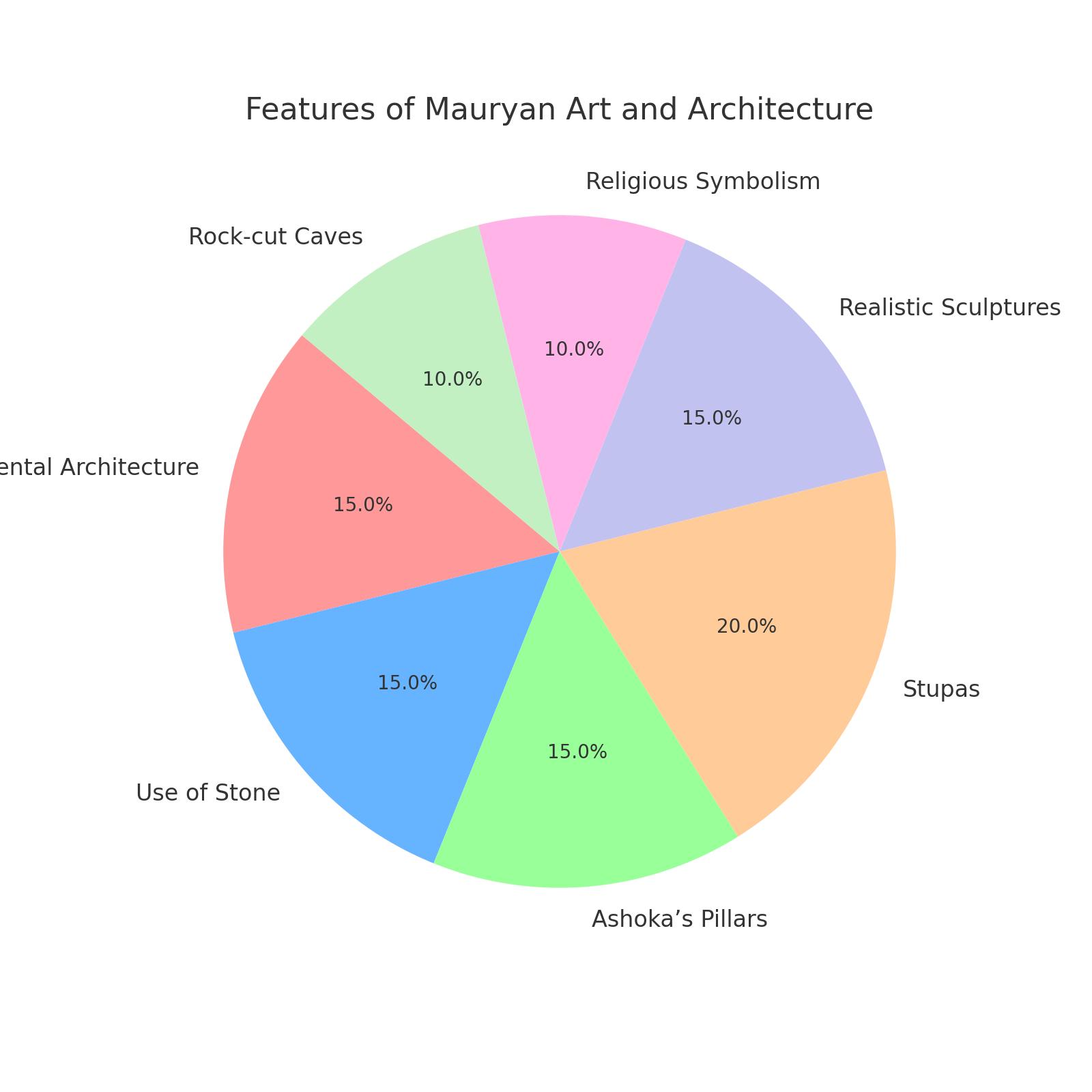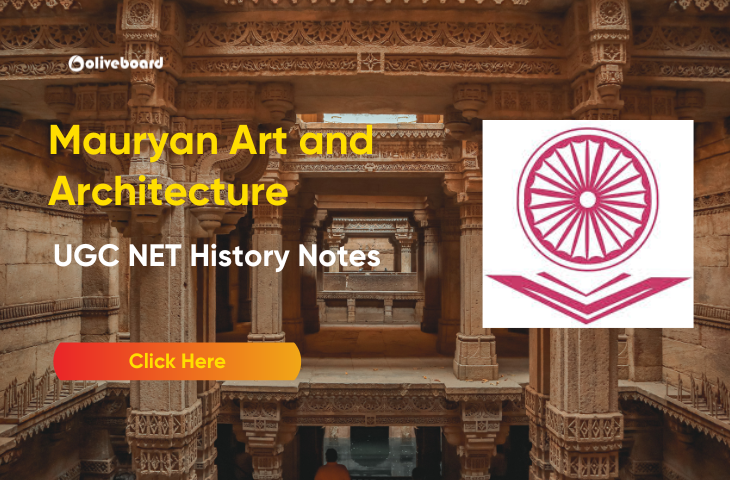Mauryan Art and Architecture, flourishing between 322-185 BCE, represents a key phase in ancient Indian culture. Under rulers like Chandragupta Maurya and Ashoka, the empire saw the construction of monumental structures, including Ashoka’s Pillars and stupas. These pillars, inscribed with edicts promoting ethical governance and religious tolerance, are iconic symbols of Mauryan architecture. The period’s artistic achievements, especially in sculpture and architecture, laid the foundation for future developments in Indian art and architecture, making Mauryan Art and Architecture an essential topic for UGC NET History.
Features of Mauryan Art and Architecture
The features of Mauryan Art and Architecture are distinct and reflect the empire’s political, religious, and cultural ethos. Some key features include:
- Monumental Architecture: Large-scale structures, including Ashoka’s pillars, stupas, and rock-cut caves.
- Use of Stone: The extensive use of stone, particularly polished sandstone, in sculpture and architecture.
- Ashoka’s Pillars: Inscribed with edicts promoting moral conduct, religious tolerance, and governance.
- Stupas: Prominent religious structures, with the Sanchi Stupa as a prime example, symbolizing Buddhist influence.
- Realistic Sculptures: Sculptures showcasing animals, human figures, and symbols like the Lion Capital of Ashoka.
- Religious Symbolism: Integration of Buddhist, Jain, and Hindu iconography in art and architecture.
- Rock-cut Caves: Early examples of cave architecture, used for religious purposes.

Categorization of Mauryan Art and Architecture
Mauryan art and architecture can be distinctly classified into two categories: Court Art and Popular Art. Let’s explore more about the Mauryan Art and Architecture:
1. Court Art
Court Art refers to the refined, sophisticated forms of art and architecture created for the royal courts, rulers, and the elite class. These works were primarily patronized by the Mauryan emperors and were meant to reflect their power, status, and religious ideologies.
Key Characteristics of Court Art
- Monumental and Majestic: Court art is characterized by large-scale structures and sculptures, often made from costly materials such as polished sandstone and metal.
- Sophisticated and Symbolic: This category of art includes complex iconography and symbolic representations of kingship, power, and religious teachings.
- Religious and Political Themes: Many of the artworks are related to the promotion of royal authority, as well as the spread of religious ideologies like Buddhism.
Key Examples of Court Art
1. Ashoka’s Pillars:
- These tall, cylindrical structures were inscribed with Ashoka’s edicts, promoting moral and religious values such as non-violence, religious tolerance, and dharma (righteousness).
- The Lion Capital of Ashoka (Sarnath) is a notable example of Court Art, symbolizing Ashoka’s kingship and Buddhist teachings.
2. Sanchi Stupa:
- Commissioned by Emperor Ashoka, the Sanchi Stupa is an architectural marvel, elaborately decorated with gateways (Toranas) depicting stories from the life of Buddha and symbolic representations of the Buddhist doctrine.
3. Palatial Architecture:
- While there is limited direct evidence of palaces from the Mauryan period, historical records suggest that Mauryan court architecture would have been grand and symbolic, designed to reflect the empire’s wealth and power.
Purpose of Court Art
- Royal Patronage: These works were created to glorify the ruler and the state, often linking the king’s identity with divine authority.
- Religious Promotion: Ashoka used art and architecture to promote Buddhism, both as a spiritual and political ideology, enhancing his image as a benevolent and just ruler.
2. Popular Art
Popular Art refers to artistic expressions that were accessible to the general public, often with simpler forms and materials. These works catered to the religious needs and cultural practices of ordinary people, as well as reflecting everyday life and folk traditions.
Key Characteristics of Popular Art
- Simple and Functional:
- Popular art is often less intricate than court art and is made from materials like clay, wood, and unpolished stone.
- These artworks served more practical and religious purposes, such as decorations for shrines or personal use.
- Local and Religious Themes:
- Popular art often focused on deities, local legends, and religious rituals that were important to the general population.
- It was meant to serve as a medium of devotion and everyday religious practice.
- Widespread Use: Unlike court art, which was often limited to the elite and monumental sites, popular art was more widely spread, especially in towns, villages, and local religious centers.
Key Examples of Popular Art
1. Yaksha and Yakshi Statues:
- These were images of nature spirits, often depicted in a larger-than-life size, serving as symbols of fertility and prosperity.
- These figures were placed at various locations, such as gateways and village shrines, reflecting the local beliefs of the common people.
2. Buddhist Rock-Cut Caves:
- While rock-cut caves like the Barabar Caves were associated with elite Buddhist monasticism, simpler cave shrines and sanctuaries catered to the popular religious practices of ordinary Buddhists.
3. Terracotta Figurines:
- Simple terracotta sculptures of gods, goddesses, and animals were created for domestic and local religious use, often found in rural and suburban areas.
- These figurines were more reflective of local religious and cultural practices.
Purpose of Popular Court
- Religious Worship: Popular art served primarily to assist in personal and local worship, with a focus on creating accessible and functional religious imagery.
- Cultural Reflection: This art also reflected the everyday lives, beliefs, and cultural practices of the common people, offering a more grounded perspective on Mauryan society.
Click Here for UGC NET History Syllabus 2024
Major Pillar Edicts of Emperor Ashoka
| Edict Number | Location | Description |
| 1st Pillar Edict | All over the empire | Ashoka expresses his moral policy and affirms the establishment of Dhamma (righteous living), which should be practiced by his subjects. He mentions the importance of truthfulness and respect. |
| 2nd Pillar Edict | All over the empire | Ashoka orders the appointment of Dhamma Mahamatras (officials) to supervise the practice of Dhamma, who would also oversee public welfare, such as the building of wells and rest houses. |
| 3rd Pillar Edict | Various Locations | Ashoka emphasizes the need for respect and tolerance toward all religious sects and moral conduct towards one another. He calls for ethical treatment of subjects, including elders, women, and religious leaders. |
| 4th Pillar Edict | Various Locations | Ashoka proclaims his commitment to religious tolerance and peace. He urges that people should avoid cruelty, hatred, and violence. |
| 5th Pillar Edict | Various Locations | This edict discusses Ashoka’s efforts to promote humanitarian actions, such as building hospitals for humans and animals, planting trees, and creating watering holes. |
| 6th Pillar Edict | Various Locations | Ashoka reiterates his commitment to Dhamma and stresses that rulers should lead by example. The king’s moral code includes fairness, justice, and helping the underprivileged. |
| 7th Pillar Edict | Various Locations | Ashoka orders the appointment of officials (Dhamma Mahamatras) to ensure that all laws are followed, the practice of Dhamma is promoted, and that the welfare of his people is looked after. |
| 8th Pillar Edict | Various Locations | Ashoka highlights his commitment to non-violence (Ahimsa) and reducing animal sacrifices. He promotes vegetarianism and kindness toward all living beings. |
| 9th Pillar Edict | Various Locations | This edict deals with prisoners’ welfare, calling for their humane treatment, granting them rights, and encouraging moral reform for those imprisoned. |
| 10th Pillar Edict | Various Locations | Ashoka calls for moral conduct in the realm, promoting the path of Dhamma by encouraging moderation in behavior and living peacefully, with respect for all communities. |
| 11th Pillar Edict | Various Locations | Ashoka expresses his remorse over the Kalinga War, pledges to uphold peace and non-violence, and urges the people to adopt Buddhist principles. |
| 12th Pillar Edict | Various Locations | This edict deals with justice and fairness in Ashoka’s governance, promoting equality before the law and ensuring that the treatment of subjects is based on righteousness. |
| 13th Pillar Edict | Kalinga (Orissa) | This is the most significant edict, where Ashoka regrets the bloodshed of the Kalinga War, emphasizing his conversion to Buddhism and a commitment to non-violence, compassion, and moral governance. |
Facts about Major Rock Edicts
- Location and Spread: These edicts were inscribed on stone pillars and rock surfaces across the Indian subcontinent, including modern-day Nepal, Pakistan, and Afghanistan, marking the extent of Ashoka’s empire and his moral outreach.
- Language: The edicts were written in Prakrit, using the Brahmi script (and sometimes Kharosthi script), which were prevalent in the Mauryan period.
- Conversion to Buddhism: The 13th Pillar Edict is significant as it marks Ashoka’s conversion to Buddhism after the brutal Kalinga War and his subsequent dedication to spreading the Buddhist path of Ahimsa (non-violence).
- Administration: The Dhamma Mahamatras mentioned in the edicts were officials appointed by Ashoka to oversee the propagation of Dhamma and promote welfare activities in the empire.
Inscriptions of Mauryan Empire
1. Ashoka’s Edicts
Ashoka’s edicts are the most famous inscriptions from the Mauryan period, recorded on stone pillars, rocks, and cave walls. Here are its features:
- Rock Edicts:
- These are inscriptions carved into natural rock surfaces.
- The 13th Rock Edict, in particular, expresses Ashoka’s remorse over the Kalinga War and his commitment to non-violence and Dhamma.
- Pillar Edicts:
- These are longer inscriptions found on stone pillars.
- Ashoka’s Pillar Edicts provide a detailed account of his ethical and moral directives, the welfare measures for his subjects, and his commitment to spreading Dhamma.
- Cave Inscriptions:
- Ashoka also inscribed several edicts in caves, such as the Barabar Caves, which were given to Buddhist monks and served as places of worship and meditation.
- These inscriptions often focus on the king’s efforts to support Buddhism and ethical governance.
2. Kalinga Edict
- It is found in Orissa.
- It marks Ashoka’s deep regret for the violent conquest of Kalinga and his decision to embrace Buddhism.
3. Lumbini Pillar Inscription
- It is located at Lumbini (modern-day Nepal), marking the place of the Buddha’s birth.
- This inscription, also commissioned by Ashoka, states that he visited Lumbini during his reign and supported its sanctity as a religious site.
4. Dhauli Rock Edicts
- It is located in Orissa
- It consist of a series of inscriptions that focus on Ashoka’s commitment to non-violence and moral governance.
- These edicts are particularly notable because they were created after Ashoka’s remorse over the Kalinga War, symbolizing his conversion to Buddhism.
5. Girnar Rock Inscriptions
- They are found near the Girnar hills in Gujarat.
- These inscriptions were created by Ashoka after his conversion to Buddhism and his subsequent efforts to spread the moral teachings of Dhamma.
6. Sanchi Stupa Inscriptions
- The inscriptions found on the Sanchi Stupa, built under Ashoka’s patronage, are among the earliest archaeological evidences of the spread of Buddhism during the Mauryan period.
- These inscriptions indicate the construction of the Sanchi Stupa as a Buddhist monument and Ashoka’s patronage of Buddhist architecture.
7. The Bhabru Inscription
- It is a rock inscription found near the Bhabru village in Rajasthan.
- It is one of the earliest inscriptions to record Ashoka’s adoption of Buddhism and his commitment to spreading its teachings.
- The inscription promotes the principles of Ahimsa (non-violence) and Dhamma (righteousness).
8. Barabar Cave Inscriptions
- It is located in Bihar
- These inscriptions, most notably the Lomas Rishi Cave inscription, were made during Ashoka’s reign.
- They indicate that Ashoka supported the Buddhist community and provided cave residences for Buddhist monks.
- The Barabar Caves were a key religious site in the Mauryan period.
9. Luniya-ki-Serai Inscriptions
- They are found in the Luniya-ki-Serai region of Bihar.
- These inscriptions are part of Ashoka’s efforts to promote Buddhism.
- They contain moral teachings that align with the values of Ahimsa and Dhamma, with an emphasis on peaceful coexistence.
Mauryan Art and Architecture Conclusion
Mauryan art and architecture, especially under Emperor Ashoka, reflect significant advancements in ancient India. The Pillars of Ashoka, with inscriptions promoting Dhamma and non-violence, and the Lion Capital symbolize the empire’s ethical governance. Notable examples include rock-cut architecture in the Barabar Caves and Buddhist stupas at Sanchi. The well-planned city of Pataliputra and Ashoka’s support for Buddhism highlight the empire’s cultural and religious impact. These contributions influenced the development of Indian art and architecture and played a key role in spreading Buddhism across the region.
UGC NET MCQ based on Mauryan Art and Architecture
Q1. Match the following Mauryan Inscriptions with their locations:
| Inscriptions | Location |
| 1. Lumbini Pillar Inscriptions | a) Sarnath |
| 2. Kalinga Edict | b) Odisha |
| 3. Barabar Caves Inscriptions | c) Bihar |
| 4. Dhauli Rock Edicts | d) Nepal |
a) 1 – D, 2 – B, 3 – C, 4 – B
b) 1 – C, 2 – D, 3 – B, 4 – A
c) 1 – D, 2 – B, 3 – C, 4 – A
d) 1 – A, 2 – C, 3 – D, 4 – B
Answer: c) 1 – D, 2 – B, 3 – C, 4 – A
Q2. Which of the following statements about the Mauryan Empire’s architecture is/are correct?
- Ashoka’s Pillars are constructed primarily of stone and have inscriptions detailing his conversion to Buddhism.
- The Barabar Caves are famous for their rock-cut temples used as retreats by Jain monks.
- The Sanchi Stupa is considered one of the earliest examples of Hindu architecture in India.
- The Lumbini Pillar marks the birthplace of Lord Buddha.
a) 1 and 4 are correct
b) 1, 2, and 4 are correct
c) 2 and 3 are correct
d) 1, 2, 3, and 4 are correct
Answer: b) 1, 2, and 4 are correct

Hello there! I’m a dedicated Government Job aspirant turned passionate writer & content marketer. My blogs are a one-stop destination for accurate and comprehensive information on exams like Regulatory Bodies, Banking, SSC, State PSCs, and more. I’m on a mission to provide you with all the details you need, conveniently in one place. When I’m not writing and marketing, you’ll find me happily experimenting in the kitchen, cooking up delightful treats. Join me on this journey of knowledge and flavors!
